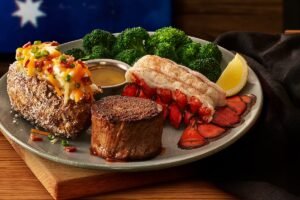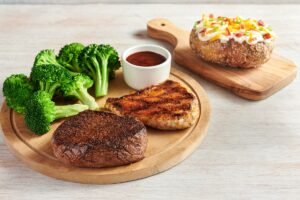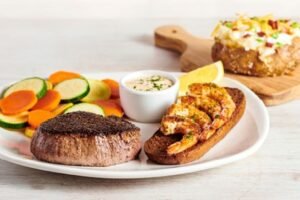Here’s what Outback figured out that your local fancy steakhouse hasn’t – most people don’t want to play menu Tetris trying to figure out what goes with what. Steak combos take the guesswork out of ordering while delivering serious value. These pre-designed meal combinations pair Outback’s signature steaks with complementary proteins, creating plates that satisfy different cravings in one shot.
The combo menu strategy launched in 2004 when Outback’s research showed that 67% of customers struggled with deciding between steak and seafood. Rather than forcing the choice, they created combinations that made both possible. Today, combo orders account for nearly 40% of all dinner entrées, proving that sometimes more really is more.
Current Steak Combo Lineup
Decoding the Combo Economics
The Real Money Math
Ordering combos saves an average of $7-12 compared to ordering items separately. Take the Sirloin & Shrimp combo at $22.99 – that same 6 oz. sirloin alone runs $18.99, and adding shrimp as a side costs $8.99. Quick math shows you’re saving nearly eight bucks while getting the exact same portions.
The psychology behind combo pricing exploits what behavioral economists call “transaction utility” – the satisfaction derived from getting a deal. Outback prices combos at roughly 75% of separate item costs, hitting the sweet spot where customers feel smart without the restaurant losing margin.
Hidden Combo Values
Every combo includes two sides, but here’s what they don’t advertise – you can mix and match premium sides at no extra charge. Swap that baked potato for loaded mashed potatoes (normally $1.99 extra) or upgrade to asparagus (usually $2.99 more) without paying the upcharge. Most servers won’t mention this unless asked directly.
Strategic Combo Ordering
The Sharing Strategy
Couples discovered that ordering one premium combo plus an appetizer often provides more food for less money than two separate entrées. The Filet & Lobster combo at $44.99, split between two people with a $10.99 Bloomin’ Onion, gives each person protein, sides, and appetizer for under $28 per person – less than most solo entrées with similar proteins.
Lunch Combo Hacks
Lunch combos (available until 4 PM weekdays) offer identical proteins in slightly smaller portions for 30-40% less. The lunch Sirloin & Shrimp runs $14.99 with a 4 oz. sirloin versus 6 oz. at dinner. Order two lunch combos at 3:45 PM and you’ve got dinner portions for lunch prices.
Off-Menu Combinations
Most Outback locations accommodate custom combo requests not listed on the menu. Want sirloin with coconut shrimp instead of grilled? They’ll usually do it, charging the difference between shrimp preparations. Filet with crab cakes? If they have the components, they’ll make it happen, though pricing gets determined by management.
Regional Combo Variations
Coastal Market Differences
Outback locations within 50 miles of coastlines offer expanded seafood combo options. Florida restaurants feature grouper combinations, Maryland locations add crab cake combos, and Pacific Northwest outlets include salmon pairings. These regional specialties reflect local preferences while maintaining brand consistency.
Test Market Innovations
Dallas and Phoenix currently test market wagyu beef combos, pairing 5 oz. wagyu sirloin with various proteins at premium price points. Nashville and Memphis locations experiment with hot chicken combinations, adding spice-rubbed options to traditional pairings.
Seasonal and Promotional Combos
Steak & Unlimited Shrimp
This legendary promotion runs twice yearly, typically January and August. For $18.99, you get a 6 oz. sirloin and literally unlimited grilled shrimp. The record at a Tampa location stands at 187 shrimp consumed by one customer (who was politely asked never to return during the promotion).
Restaurant margins shrink to near-zero after the seventh shrimp serving, but the promotion drives traffic during traditionally slow periods. Servers report average consumption around 18-24 shrimp per customer, keeping the promotion profitable.
Holiday Combinations
Valentine’s Day brings the “Love at First Bite” combo featuring twin filets and twin lobster tails for $69.99. Father’s Day introduces the “Big Dad” combo with 20 oz. porterhouse and full rack of ribs. These limited-time combinations generate significant buzz and social media engagement.
Nutritional Navigation for Combos
Caloric Realities
Steak combos range from 890 calories (lunch sirloin and grilled shrimp with vegetable sides) to 2,400 calories (ribeye and ribs with loaded potato and mac & cheese). The average combo with standard sides delivers 1,400-1,600 calories, representing 70-80% of daily caloric needs for most adults.
Adding sauces and butter increases caloric load by 200-400 calories. The lobster tail’s drawn butter alone adds 240 calories, while BBQ sauce on ribs contributes another 120 calories per quarter rack.
Protein Overload Considerations
Most combos deliver 60-90 grams of protein, exceeding single-meal recommendations for average adults. Fitness enthusiasts specifically target these high-protein options post-workout, while others might experience digestive discomfort from protein excess.
Balancing Your Combo Plate
Nutritionists recommend specific modifications for healthier combo consumption. Choose grilled shrimp over coconut shrimp (saving 340 calories), select steamed vegetables over loaded potatoes (saving 420 calories), and request sauces on the side for controlled application.
Preparation Timelines and Kitchen Coordination
The Combo Challenge
Preparing combos requires precise kitchen coordination since different proteins need different cooking times. Lobster takes 8-10 minutes, steaks vary from 6-14 minutes depending on cut and temperature, while shrimp need just 3-4 minutes. Kitchen staff use a “backward planning” system, starting longest-cooking items first.
During peak hours, combo orders stress kitchen capacity more than single-item orders. Each combo requires multiple grill stations, potentially involving three different cooks. This complexity explains why combos sometimes take 5-8 minutes longer than individual entrées.
Server Insights and Ordering Intelligence
What Servers Know
Experienced servers guide combo selection based on subtle cues. First-time visitors get steered toward Sirloin & Shrimp – safe, satisfying, and representative of Outback’s strengths. Date nights trigger Filet & Lobster suggestions, while groups hear about shareable options like Ribeye & Ribs.
Servers earn higher tips on combo orders (averaging 18% versus 15% on single entrées) due to perceived value delivery. They’re incentivized to suggest combos but trained to read the table – pushing combos to someone wanting a simple steak irritates customers and reduces tips.
Timing Your Combo Order
Order combos at the beginning of your meal rather than after appetizers. The kitchen needs the extra preparation time, and you’ll avoid the awkward wait while others finish eating. If sharing appetizers, explicitly tell your server to pace the meal – otherwise, combos might arrive while you’re still working through that Bloomin’ Onion.
Competitive Landscape Analysis
How Others Stack Up
Texas Roadhouse offers similar combinations but limits options to predetermined pairings. LongHorn Steakhouse prices combos more aggressively but uses smaller portions. Logan’s Roadhouse abandoned combination pricing entirely, forcing separate item orders.
Outback’s flexibility in combo customization and portion sizing gives them market advantage. Customer surveys consistently rank Outback’s combo value highest among casual dining steakhouses, with 78% rating combinations as “excellent value.”
Fast-Casual Disruption
Newer fast-casual concepts like Firebirds Wood Fired Grill target the combo market with simplified options at lower price points. Outback responds by emphasizing portion size, preparation quality, and full-service experience elements that fast-casual can’t replicate.
Future Combo Trends
Plant-Based Combinations
Outback tests plant-based protein combinations in California markets, pairing traditional steaks with Impossible Burger preparations or plant-based “shrimp.” Early results show 12% adoption rates, primarily among flexitarian diners wanting to reduce but not eliminate meat consumption.
Global Fusion Combinations
Development kitchens experiment with international flavor combinations – Korean BBQ ribeye with kimchi shrimp, Mediterranean sirloin with lamb kofta, Mexican street corn-crusted steak with chili-lime prawns. These combinations target adventurous millennial and Gen Z diners seeking Instagram-worthy plates.
Maximizing Your Combo Experience
The Perfect Combo Order
Start with a lighter appetizer (skip the Bloomin’ Onion if you’re getting a combo). Choose your combo based on contrast – if you want steak, pair it with seafood rather than more red meat. Select one indulgent side and one lighter option for balance.
Request sauces on the side to control flavor and calories. Ask for a to-go box when ordering – combo portions often exceed single-meal capacity, and planning for leftovers prevents overeating and food waste.
Beverage Pairings That Work
Beer pairs better with combos than wine since you’re dealing with multiple flavor profiles. Fosters (obviously) gets pushed hard, but IPA’s bitterness cuts through rich combinations effectively. For wine drinkers, medium-bodied reds like Malbec handle the protein variety better than specific varietal pairings.
The Bottom Line on Combos
Steak combos represent Outback’s understanding that modern diners want variety, value, and simplicity in their dining choices. These combinations eliminate decision paralysis while delivering satisfying meals that justify the price point and effort of dining out.
Whether you’re a surf-and-turf traditionalist or an adventurous eater mixing proteins in unexpected ways, the combo menu offers something that’ll hit the spot. The key is understanding what you’re ordering, how to customize it to your preferences, and recognizing the value proposition beyond just the dollar savings.
Next time you’re staring at that menu, wrestling between the steak you came for and the shrimp that caught your eye, remember – at Outback, you really don’t have to choose. The combo menu exists precisely because life’s too short to limit yourself to just one protein, especially when they’ve figured out how to make multiple proteins work together in perfect, indulgent harmony.






